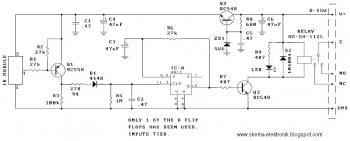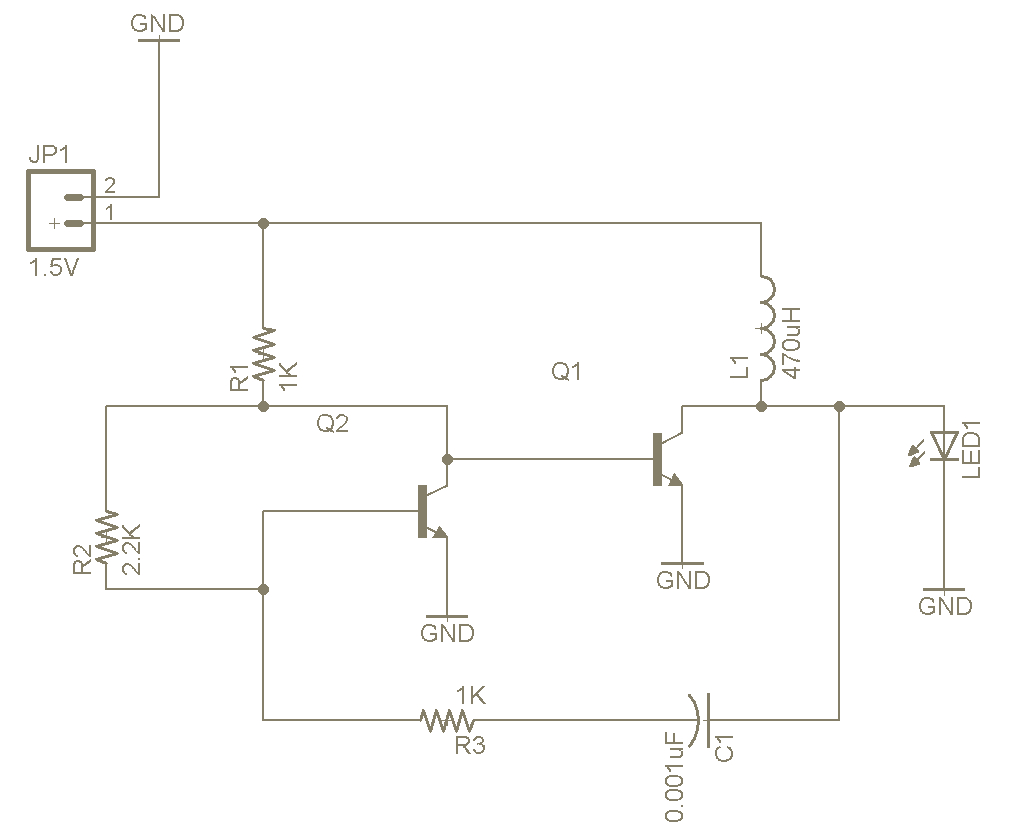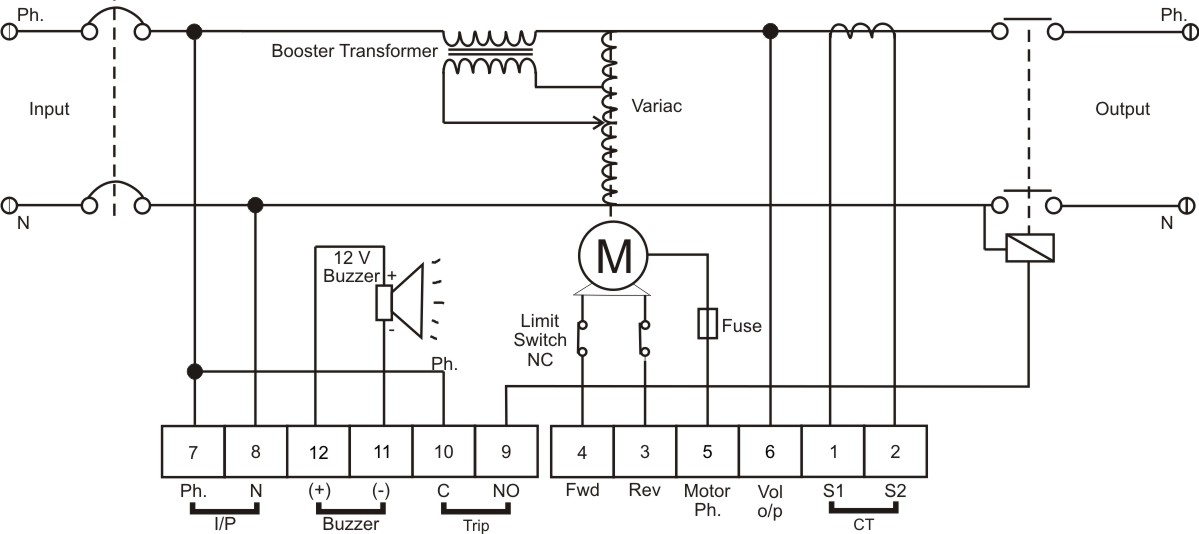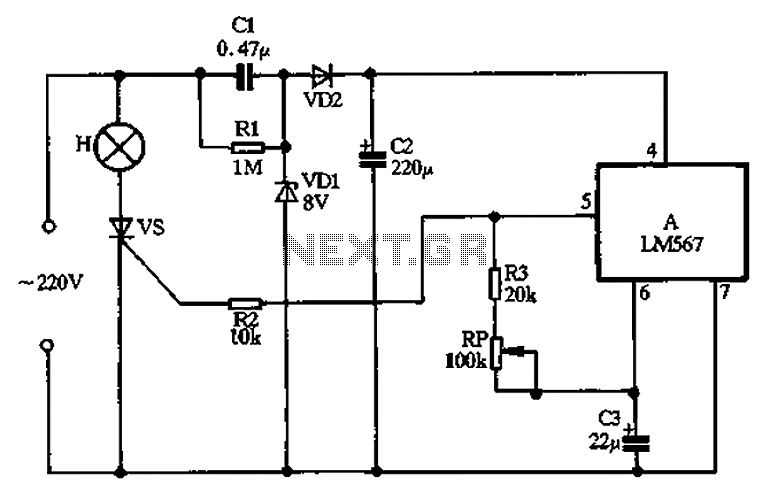
Infrared Remote Controller
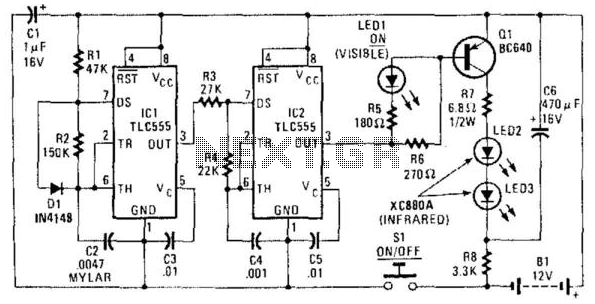
The transmitter is constructed using two CMOS 555 timer ICs (TLC 555s). It generates a modulated 35-kHz infrared signal. The carrier frequency of 35 kHz is produced by IC2, while IC1 generates a 1,500-Hz modulating signal. The output from IC2 drives LED1 through resistor R5, providing a visual indication that the transmitter is operational. Additionally, IC2 controls transistor Q1, which in turn drives two infrared LEDs (LED2 and LED3). To supply the high current required for the two IR LEDs, capacitor C6 is precharged, and its stored charge is released when switch S1 is pressed. When S1 is not engaged, power to the ICs is cut off, but C6 remains charged via resistor R8. When S1 is pressed, the current stored in C6 can power the LEDs for up to 0.2 seconds, which is sufficient time for the receiver to detect the signal.
The transmitter circuit utilizes two 555 timer ICs configured in astable and monostable modes to generate the required modulated infrared signal. The first timer, IC1, operates in monostable mode to create a 1,500-Hz signal, which serves as the modulation frequency. This signal is fed into the second timer, IC2, which is set up in astable mode to produce a continuous 35-kHz carrier wave. The output of IC2 is connected to a visual indicator, LED1, through a current-limiting resistor (R5), allowing users to confirm that the transmitter is functioning correctly.
Transistor Q1 acts as a switch that controls the power to the two infrared LEDs (LED2 and LED3). When the circuit is powered, the precharged capacitor C6 provides the necessary current to drive the LEDs, ensuring they emit infrared light effectively. The precharging of C6 is accomplished while the circuit is in a standby mode, with R8 maintaining the charge when switch S1 is not pressed. Upon pressing S1, the stored energy in C6 is released, powering the infrared LEDs for a short duration (up to 0.2 seconds). This duration is designed to ensure that the receiver can pick up the transmitted signal without requiring continuous power.
The circuit design emphasizes efficiency and simplicity, making it suitable for applications where a brief burst of infrared transmission is needed. The use of CMOS technology ensures low power consumption, making it ideal for battery-operated devices. The combination of the 555 timers, the transistor switch, and the precharging capacitor creates a reliable and effective transmitter circuit for infrared communication. The transmitter is built around two CMOS 555 timer ICs (TLC 555s). The transmitter generates a modulated 35-kHz IR signal. The 35-kHz carrier frequency is generated by IC2, and the 1 500-Hz modulating signal is generated by IC1. The output of IC2 drives LED1 through resistor R5; that LED provides visual indication that the transmitter is working.
In addition, IC2 drives transistor Ql, which drives the two infrared LEDs (LED 2 and LED 3). To provide the high current needed to drive the two IR LEDs, capacitor C6 is precharged, the charge it contains is dumped when SI is pressed. When SI is not pressed, the power to the ICs is cut off. However, C6 is kept charged via R8. Then, when SI is pressed, the current stored in C6 can be used to drive the LEDs for as much as V2 second.
That"s plenty of time for the receiver to pick up a signal.
The transmitter circuit utilizes two 555 timer ICs configured in astable and monostable modes to generate the required modulated infrared signal. The first timer, IC1, operates in monostable mode to create a 1,500-Hz signal, which serves as the modulation frequency. This signal is fed into the second timer, IC2, which is set up in astable mode to produce a continuous 35-kHz carrier wave. The output of IC2 is connected to a visual indicator, LED1, through a current-limiting resistor (R5), allowing users to confirm that the transmitter is functioning correctly.
Transistor Q1 acts as a switch that controls the power to the two infrared LEDs (LED2 and LED3). When the circuit is powered, the precharged capacitor C6 provides the necessary current to drive the LEDs, ensuring they emit infrared light effectively. The precharging of C6 is accomplished while the circuit is in a standby mode, with R8 maintaining the charge when switch S1 is not pressed. Upon pressing S1, the stored energy in C6 is released, powering the infrared LEDs for a short duration (up to 0.2 seconds). This duration is designed to ensure that the receiver can pick up the transmitted signal without requiring continuous power.
The circuit design emphasizes efficiency and simplicity, making it suitable for applications where a brief burst of infrared transmission is needed. The use of CMOS technology ensures low power consumption, making it ideal for battery-operated devices. The combination of the 555 timers, the transistor switch, and the precharging capacitor creates a reliable and effective transmitter circuit for infrared communication. The transmitter is built around two CMOS 555 timer ICs (TLC 555s). The transmitter generates a modulated 35-kHz IR signal. The 35-kHz carrier frequency is generated by IC2, and the 1 500-Hz modulating signal is generated by IC1. The output of IC2 drives LED1 through resistor R5; that LED provides visual indication that the transmitter is working.
In addition, IC2 drives transistor Ql, which drives the two infrared LEDs (LED 2 and LED 3). To provide the high current needed to drive the two IR LEDs, capacitor C6 is precharged, the charge it contains is dumped when SI is pressed. When SI is not pressed, the power to the ICs is cut off. However, C6 is kept charged via R8. Then, when SI is pressed, the current stored in C6 can be used to drive the LEDs for as much as V2 second.
That"s plenty of time for the receiver to pick up a signal.
